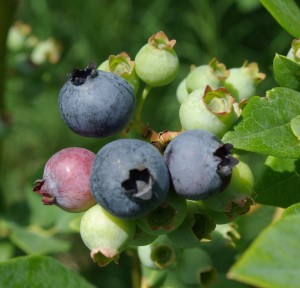 Highbush blueberry is a high-value, specialty crop. Once established, an acre of blueberry bushes can produce around 7,000 pounds of berries, according to a University of Georgia Agricultural Extension bulletin. Blueberries grow well in acidic, well-drained soil and require cold weather to trigger flowering the spring, called “chilling.” The amount of chilling depends on the variety.
Highbush blueberry is a high-value, specialty crop. Once established, an acre of blueberry bushes can produce around 7,000 pounds of berries, according to a University of Georgia Agricultural Extension bulletin. Blueberries grow well in acidic, well-drained soil and require cold weather to trigger flowering the spring, called “chilling.” The amount of chilling depends on the variety.
Thanks to high profit potential and increasing consumer demand, blueberry acreage has been steadily increasing in the United States since the early 1900s, when USDA botanist Frederick Coville and New Jersey agriculturalist Elizabeth White developed the first commercial berry varieties from wild plants.
Blueberries are popular because of their flavor, but also because consumers think eating berries provide health benefits above and beyond basic nutrition.
From 2009 to 2014, we worked with colleagues from NC State University, UNC Charlotte, and USDA to sequence and annotate a highbush blueberry Vaccinium corymbosum, one of two major species important in blueberry agriculture. The Loraine Lab role was to perform transcriptome sequencing and profile gene expression dynamics during berry fruit development and ripening. We also produced and annotated gene models with the goal of better understanding how blueberries develop and ripen during a season.
This project was funded by the office of Steven Leath, during his tenure as Vice President of Research, University of North Carolina General Administration.
To find out more, see:
- Gupta V, Estrada A, Blakley I, Reid R, Patel K, Meyer M, Andersen S, Brown A, Lila M, Loraine A (2015) RNA-Seq analysis and annotation of a draft blueberry genome assembly identifies candidate genes involved in fruit ripening, biosynthesis of bioactive compounds, and stage-specific alternative splicing. GigaScience 4: 5 PMID: 25830017
- Data analysis source code repository at BitBucket.org. Use this to repeat analyses presented in the paper. The code repository also contains analyses that space and time constraints did not permit us to publish, including new and improved cluster analysis of differentially expressed genes. Blueberry genome annotation QuickLoad site. (These data are formatted for visualization in Integrated Genome Browser.)
- Slides from a presentation given at Plant Animal Genome Conference, Jan 2014
